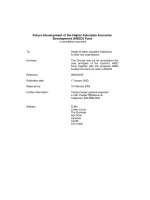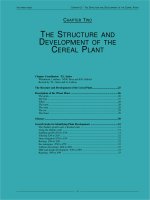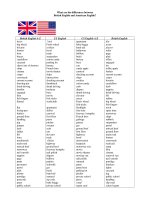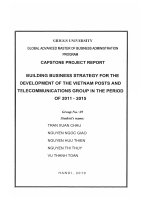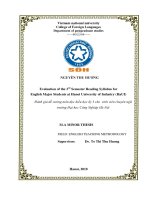ASSIGNMENT ON HISTORY AND DEVELOPMENT OF THE ENGISH LANGUAGE differences between old english and modern englỉsh
Bạn đang xem bản rút gọn của tài liệu. Xem và tải ngay bản đầy đủ của tài liệu tại đây (335.54 KB, 18 trang )
HANOI OPEN UNIVERSITY
EACULTY OF ENGLISH
ASSIGNMENT ON HISTORY AND
DEVELOPMENT OF THE ENGISH LANGUAGE
Differences between Old English
and Modern Englỉsh
Full name: Chu Thi Linh
Class: K25A12
Hanoù 2020
1
TABLE OF CONTENTS
PART A: INTRODUCTION
1. Rationale................................................................................................3
2. Aim of the study....................................................................................3
2. Research questions................................................................................4
PART B: LITERATURE REVIEW
Chapter 1: An Overview of Modern English and Old English
1. The Old English...................................................................................5
2 Modern English.....................................................................................6
Chapter 2. The different between Old English and Modern English
1. The different vocabulary between Old English and Modern English.8
2. spelling of Old English and Modern English.......................................9
3. The different Words.............................................................................11
4. The different Grammar between Old English and Modern English...12
CHAPTER 3: English changing and developing in the future
1. The changing of English......................................................................14
2. English in the future.............................................................................14
3. The Development of English...............................................................15
PART c 9 CONCLUSION........................................................................16
REFERENCES.........................................................................................17
2
PART A: INTRODUCTION
1. Rationale
The stages of English language has been described in an elaborated way. The
history of a language is constituted up of some internal and external factors. The
external factors like economic, political, social, as well as geographical affect the
speakers of a language internally, i.e. their life style, food, habitats and their style of
speech which include vocabulary, accent, and even the structure of the language.
This briefly discussion will be structured around the internal history of the
English language - the pronunciation, grammar, vocabulary, and around the
conventional division of the history of English into two main periods: Old and
Modern English.
Today, on almost any basis, English is the nearest thing there has ever been to
a global language. Many would reasonably claim that, in the fíelds of business,
academics,
science,
computing,
education,
transportation,
politics
and
entertainment, English is already established as the de facto lingua franca.
English is looking to be one of the universal languages of the future. Many
people know that English speaking countries have some of the best economic and
technological developments the world can offer. It’s also usually a case that English speaking countries often offer higher paying jobs, which means people in these
countries usually have a better standard of living, in comparison to the rest of the
world. This is part of the reason why people believe English will be the Universal
Language of the future.
4. Aim of the study
Old English, Middle English, and Modern English are the classification of
English language, and they exhibit some differences between them. There is one
significant fact that English has become the official language of so many other
countries where it is not considered as the native language which made it apart from
many other languages that are spoken all around the globe.
As the world develops in terms of educational standards, more and more people
are choosing to study English as a second language. In this day and age, the
opportunities that are available to you if you can read, speak, and write in English
3
are much more desirable than other languages. The potential for jobs, to expand on
your knowledge, and to generally speak with more of the world’s pop ulation will all
improve when capable of communicating in English.
3. Research questions
How and why has English changed over time?
What is the difference in grammar between old English and modern English?
Why do people think English is the language of the future?
What are the factors that contributed to the growth of English language?
4
PART B: LITERATURE REVIEW
Chapter 1: An Overview of Modern English and Old English
1. The Old English period: (450 - 1150)
languapấcrr58itfel;d^BiIỈSíghs>ẩẴKnẽíÉsfm5fte(ịSW1ỉ&ếỉfDfí>tễẩniẫl?ẵl?CP1ỄJS,í|álydCiifỉ>tÁĨ
Western Germany and Denmark. These tribes spoke a similar language developed into Old
English. Old English survived until the Norman invasion in 1066 by William the
Conqueror conquered England.
The Old English was a language of full inflection; linguistically a synthetic language
and which had a peculiar characteristic. Old English vocabulary was almost Germanic, of
which 85% does not exist at present day. “Much of the Old English vocabulary appropriate
to literature and learning died out and was replaced later by words borrowed from French
and Latin.” OE was mostly written using the L atin alphabet, supplemented by a few
Germanic runic letters to represent sounds not found in Latin.
Old English had many inflected forms of nouns, verbs, and adjectives that were very
similar to those of German. Nouns had gender: feminine, masculine, and neuter. Adjectives
agreed with the nouns they moditìed in gender and case. Verbs had six forms in every tense
showing person and number. Old English had a somewhat freer word order than modern
English. Old English had a few extra letters in its alphabet and much easier to spell.
2 Modern English
Beginning in the 15th century, the transition from Middle English to Modern
English began. Much of the transition was due to the expansion of the British Empire
throughout the world and to the development of printing. The printing press and
increase in publishing of books drove the standardization of the language. Spelling
and grammar was formalized due to the publication of various literary works and
pamphlets.
At the same time the seventeenth-century scientiíìc movement, heralded preeminently by Francis Bacon, had the effect of establishing English íìnally as an
adequate medium of technical writing in place of Latin. It also led to the
cultivation of a plain style of writing, without the use of the devices of rhetoric.
Bacon, who wrote in both English and Latin, himself criticized the valuing of style
above matter. His followers carried the attack much further. The Royal Society,
according to its historian, Bishop Thomas Sprat, was to be praised for correcting
stylistic excesses in writing.
ENGLISH
When a native English-speaker tries to learn another European language, one
of the very first thing that person will discover is that all nouns are either masculine
or feminine, or in some cases neutral. In modern English, on the other hand, a noun
is a noun.
In modern English new words are added to express past or future tense. The
inflection occurs when we change the word itself to give us information, usually by
changing the end, the middle or some other part of the word. However, modern
English did not get rid of all its inflections. When we study English today we
discover that in words such as “play,” we would have “played,” “playing.”
Chapter 2. The different between Old English and Modern English
Peature
Aíphabet
Pronunc iation
VocabUary
ồrammat
olđ English
Had no k„ v.t letters {1 he tetterỉ c, s
indứ ! bothc and k, f and V, > and z
5QUfldsJ
e.g. cynn 'kin', cinn 'thin*
gleCan ‘10 give\ 5P0ÍOI1 'seven'
hũs'house*, bõsm 'bosom'
Had nữ teĩter q.
e,£. cwỉn 'qụpen'
Modern Enghỉh
Hai these three letters
separatety.
The letter qenrered The Englkh
la ngụa ge through Frertth icríbei,
and tontinuex.
Thí- leitet e indicated 1 he sounds of g as
XVPÍI a$ y,
e.g. gõd 'ẸOOCT, gẽar 'year'
These txvo leitert are diỉtiiưtly
separate now.
ỉhere were no 'LĨtent' letlers, A1I the IvTteiv
had a sound valưe. e. 6- oight
The letteis gh indkaied a veíat kkdtive
sound, xvhich rị now Ịost in Modern Englbh.
ĩhere lísed to be a h sound at the
begĩnnìngof a word. E.g, hnecta 'neck'
Ai a result loss Intỉectìonat
endingỉ-. Great Vovvt‘1 Shiftr and
other lơund changes, Modern
Engiiỉh deveíoped 'silent' lettPtĩ.,
Modtrn Ẽnglish does not alloxv a
h sotind beíore a consonant
spund xvord inidallv,
vvơrd inĩEỉal k sound was pemũtted. E g.
kniỉe. The k letter ivas pronouoced
Modein English doesnot allovu <ỉ
kíoưnd beíorc-ancther
C0níor>aiH soundxvord iniỉialiy.
Some worcfc hađ a diííeient meaning. E.g.
mid 'wỉthí >v7f ' womar?
So me xvorđs đisappeared E-g wer
Sxveín 'dream'
TheS&cond Person pronoun had both
sỉngular and phiral form$. ỮO 'vou (ỉingb
gẽ 'you' (pỈLtral)
Today the xvords rtĩíờ, and wi/e
have dờíerent meanings.
Modern English has other words
for them.
Modetn Enghsh has only one
prpnoini you to indicate both
ỉìngular and [rturat torms.
The Pirst Person and the Second Persữtì
pronouns bad dual íornts Indkating two
people. h.g. XV11 'xve twú', RÍĨ 'von txvo'.
old Engíìsh had norlexíve prpapuns li ke
nìyselC atuselves, yourselí etc
Modern Englísh lost these dual
prottèuni.
Nouns, adjectivest and even artictes íiad
gendersThe tntinrtive XV. 15 índĩcaied hy adđĩng a
ỉụííìx -an to the verb. E.g. bacan 'to bake'
Nouns, adiecdves and artkks vvere
ìnílected for Case.
Modern English lost its oiiginal
genđer systein.
Englíỉh lost thi$ ỉuHìx durĩng the
Middle Engli$h períod ĩtíẹlí.
The case System was ỉost at the
time of Middle Engliỉh.
Re la ti VÉ ụEonộuns íănip tộ be
used linceihe Mĩddl? Englìỉh
peiĩod.
Double negative iỉ no longer
usedJ
ĩhí-re tverẹ lìO Relatĩve pronoun^
Dữuble Ne ga ti ve wai com mon, not to ma ke
a pcniũve Ont, but only 10 reintũrce the
negattve senie.
Word orđer v/ai íree.
These rlexive pTOPCuns i:ame to
exist ìn Engthh đuringthe Mìddle
Engli^h period.
Word order ĩs íĩxed
7
Chapter 2. The different between Old English and Modern English
Questions tould be íomied vvithOLit 'do'.
E.g. Know yau lùm ?
Modein Ẹngliỉh íỉoes not alloxv
such túnỉtructkHlỉ
8
The period of Old English with its main phases: from the arrival of the AngloSaxons, via the constant invasions of the Vikings up to a detailed account of what
happend in 1066. Thus, this video is more or less socio-culturally oriented, rather
than linguistic. It is meant as a general overview of the most important facts and
figures of the Old English era : Old English Words and Modern
A lot of words and grammar were absorbed from Old Norse. The Danes had
conquered and ruled much of northern/eastern England, and their language
assimilated with the local variant of English. We get a lot of our most common
words, including many pronouns, from Norse.
So, practically speaking, old English was a completely different language from
modern English, and the differences between these two are not coníìned to only
spelling, but extend to grammar, sentence structure, vocabulary, and meanings. the
language is highly inílected; not only verbs but also nouns, adjectives and pronouns
are inflected there is grammatical gender with nouns and adjectives
Old English and Modern English are not two different entities. Old English kept
on changing until it became what today we call Modern English. So, Modem English
is merely a continuation of Old English, and Old English was the precursor of
Modern English.
1. The different between vocabulary
In terms of written example, let me use ‘The Lord’s Prayer’ as example.
Our Father, who is in heaven, hallowed be your name. Your kingdom come,
your will be done on Earth as it is in Heaven. Give us this day our daily bread, and
forgive us our sins, as we forgive those who sin against us. Lead us not into the test
but deliver us from evil. Amen.
Now, in Old English:
F^der ure ^u ^e eart on heofonum; Si ^in nama gehalgod to becume ^in rice
gewur^e ỗin willa on eorỗan swa swa on heofonum. Urne ged^hwamlican hlaf syle
us todéeg and forgyf us ure gyltas swa swa we forgyfaỗ urum gyltendum and ne
gehed ^u us on costnunge ac alys us of yfele so^lice.
We denotes its tense, number, or part of speech. A plural is an inflectional
ending (one apple, two apples; one child, many children) and so is a possessive (a
Kaoma—s o a dofdW sndinn?f&inoteltionfii3gs%h5®’ipsldmnlìh
9
was a direct or indirect object. A lot of vocabulary was absorbed from French.
French was the language of court, law, and much official business, and remained so
until the 1300s.
Then there’s vocabulary. Old English has a vocabulary that was presumably big
enough for the people who spoke it to describe everything they cared about. Modern
English, though, has scavenged words from pretty much every other language in the
world, and has an enormous and flexible vocabulary with multiple words for all sorts
of things and concepts and actions.
Another feature of Old English was the verb system, which was more complex
than that of modern English. In modern English, regular verbs are conjugated in the
same form for all subject pronouns or persons, with only one exception, namely the
present tense indicative, third person singular (he/she/it steals), Old English had
different endings for different persons.
The changes in nouns and adjectives (the end of declensions, especially
following prepositions), the establishment of pronouns familiar to . the modern
speaker (with conservaủon still of thy, thine and ye), further reduction in the classes
of strong verbs, increase in use of progressive verb forms, and growth in vocabulary
from various sources as foreign loanwords encountered in trade and exploration
enter into and enrich the language.
Regarding the vocabulary of Old English, it was also different from that of
modern English. Old English vocabulary was still based on the Germanic peoples'
dialects that had moved down from Scandinavia and spread over Central Europe in
successive waves.
2. Spelling of Old and Modern English
1
0
Mộd Ẹngh>h
3*1
ÍVLI
ÍVỆỌÍ
ilan
cyning
fợwí
stone
king
íưtụ
[cv»
ỉunne
wp
miht
õlhl
ship
_ rr^ht
Cyrite
hMCCt
churth
Cild
child
tun
h4fll
bcne
hom*
bui
hpuie
keỹ
lojf
bryd
brtổẹ
cw#n
(ỊUMn
Many of the Old English words also came from iníluence of the Romans and
Greeks. These words were borrowed by the Germanic conquerors and incorporated
into Old English. For example, the following words were adapted from the Romans,
Greeks and from Latin. While the spelling is different, the meanings all follow the
original words and correspond to the modern meanings.
Spelling changed. Much of the writing was being done by French trained
sbribes, who didn’t like the look of some traditional OE spellings. English
completely lost ỗ (eth) and b (thorn) which were used for the TH sound but unloved
by„theNQrmanscribes. ThPrẲetter in (ash) went away too. Pronunciation4s also rVerYi
verydiiỉerentrrModern dayEngnsnpTonunciauanisa Dy-product oftheGreat vowel
Shift that obbured. It’s the reason why house is pronounbed as ‘hows’ rather than the
spelling pronunbiation of ‘hose/haws’.
All these words underwent several different types of changes, resulting in the
modern forms. That said, it should not be presumed that the old English letters like
‘g’ were pronounbed like modern English ‘g’. It indibated several sounds. So was
the base with old English ‘b’.
The phonology has undergone some bhanges (for example, the “zh” sound as in
“genre” is now part of Modern English. The spelling and pronunciation has changed
1
1
signiíìcantly. The semantics / meanings of numerous words have changed, some
quite significantly (for example, “girl” used to mean a child of either sex)
Examination of Old English words along with their modern meanings can give
you a glimpse of how languages develop through time. The fírst form of English as
a language is termed Old English and came into being during the 5th century.
Many common words and verbs can be found in Old English that hold the same
meaning today. For example: Strong, Water, Be
By reviewing literature written in the period that Old English was used you can
see the many Old English words that are very similar to words found in modern
English. For example:
Eald - means old
Brodor - means brother
Riht - means right
1L can oe diiiicu.lL to detpiiiune Lhe moueinmeaning. OI some Old English woids
because there are oiten mũlũple woras whicn nave srmilar meanrngs. Fỡr example,
three descriptions of females are:
Widuwe - stands for widow
Wif - means wife
Wifmann - the term for woman
3. The different between Words
Modern English has tons of loanwords from Romance languages—especially
French and Latin. Old English is much more Germanic in vocabulary. Modern
English has singular and plural forms for pronouns. Old English has singular, plural,
and dual forms of pronouns.
Old English primarily uses “strong verbs” in which the vowel changes in the
middle of the verb indicate the past tense. It also has a smaller number of “weak
verbs” in which you add a dental suffix (-ed or -t) to indicate the past tense. That’s
the opposite of Modern English, where the vast majority of our verbs are “weak
verbs” and we have only sixty or so “strong verbs.”
Some things that are allowed in modern English would not be permitted in old
English, for example, the use of the plural pronoun for gender-neutral nouns and
pronouns. Like, it’s all right to say: “Everyone should be ing their own material to
1
2
the class.” Here, “their” is plural but since everyone is gender -neutral, this is fine.
This statement would be wrong in old English, where you would need to say:
“Everyone should bring his or her own material to the class.”
Everything is different. Old English had very elaborate grammar, with an
extensive system of declensions, conjugations, and genders. Modern English nouns
have two forms (bird, birds); Old English had eight - sometimes ten.
Punctuation was almost non-existent in Old English. It has developed slowly
over the centuries. Modern English mostly uses word order to accomplish this.
Subjects go before verbs, adjectives and adverbs go before the words they modify,
indirect objects can go before or after a direct object, but if the direct object comes
second we use a word like “to” to show. Nouns have lost almost all case marking.
The possessive has gone from a case on a noun to a marker on a phrase.
“The big yellow dog gave me a kiss.” “The big yellow dog gave a kiss to me.”
4. Grammar
That said, there are certainly differences between Old English and Modern
English. Old English has a much more complicated grammar, something like
modern German; Modern English has an extremely stripped-down grammar. (On
one hand, this simple grammar makes Modern English somewhat simpler to learn except that it also makes Modern English totally dependent on word order.
The grammar of Old English is more complex, because it is an inflected
language, with assorted cases to learn. But the real difficulty is that you will struggle
to find material to work from that has any relevance to life today. It is nearly a
thousand years since anyone routinely spoke Old English.
Modern English speakers began to rely more on word order. Old English word
order was more flexible than Middle and Modern English, where sentences almost
always start with the subject, then proceed to verb and object. There is noun
inflections in the form of grammatical cases. Sentence structure is also not entirely
similar to modern English though to be honest, it’s only minor differences in terms
of syntax. ME became set in what is called Subject-Verb-Object order.
I gave a ball to Joe has a subject (I), a verb (gave), a direct object (ball) and an
indirect object (Joe). If you change the word order to A ball gave to I Joe it makes
no sense.
1
3
Old English could do that, because the three nouns in the sentence would all
have a different ending that let the listener know what their function was. Our
modern sentence structure dates to this transition.
Because of the inflection word order was not as strict as it now is and by default
it was arranged more like modern German than modern English. Old English is a
synthetic language that relies on declensions to make meaning, so word ord er isn’t
all that important. Modern English is an analytic language that relies on word order
to make meaning, but it doesn’t make extensive use of declensions.
Verb conjugations were also far more complex as compared to modern
conjugations which to be honest, is as easy as it can be. Many verbs have moved
from one of the strong conjugations (“irregular verbs”) to the weak (“regular verbs”),
and a few have gone from weak to strong (e.g., dive/dove instead of dive/dived).
Many grammatical features also date back to this time: irregular verbs such as
drink ~ drank ~ drunk (OE drincan ~ dranc ~ (ge)druncen) parallel German trinken
~ trank ~ getrunken. Similarly, many OE pronunciations are preserved in modern
spellings e.g. knight (OE cniht, German Knecht), in which k would have been
pronounced and gh sounded like ch in Scots loch.
Norse influence may also have contributed to an important grammatical change,
which mainly occurred in English between the llth and 14th centuries, and which
marked the transition to Middle English (ME) (conventionally dated c.1100-1500).
OE had indicated many grammatical categories and relationships by attaching
inflections (endings) to word roots, in a similar way to Latin or German. Thus, in the
OE clause wolde guman íĩndan ”he wanted to find the man’, the -e on wolde
indicates a 3rd person singular subject: ”he wanted’; the -n on guman indicates that
”the man’ is the object, not the subject of the verb; and the -an on íìndan indicates
an iníĩnitive: ”to find’. In ME, changes in the p ronunciation of unstressed syllables,
mainly occurring at the ends of words, caused most inflections to merge
indistinguishably, or be dropped altogether. This inflectional breakdown could have
created ambiguity (e.g. wanted man find), but speakers compensated by using more
rigid word order (subject - verb - object, usually), among other strategies.
So Old English: complex grammar, smallish vocabulary. Modern English:
simple grammar dependent on word order, huge vocabulary with subtle shades of
meaning
1
4
CHAPTER 3: ENGLISH CHANGING AND DEVELOPING IN
THE FUTURE
1. The changing of English
English is undeniably becoming the global language of the future with fabts and
stats to prove it. If English became a universal language, the world will bhange in a
range of different ways, whether that be communication, trade, or culture. People
have different theories on what effect English as a Universal Language will have on
the world, and its competing languages.
The English language has seen an increase in popularity, with more and more
people choosing to study English as a second language. If English became a global
language, then opportunities could open up, however there could also be a
signiíìcant effect on culture. Having English as a universal language has the
potential to make the world more peaceful as well as help to advance
bommunibation throughout the world, but that doesn’t mean there aren’t any
disadvantages to English as a global language either.
English is looking to be one of the universal languages of the future. Many
people know that English speaking countries have some of the best economic and
tebhnologibal developments the world ban offer. It’s also usually a base that
English-speaking countries often offer higher paying jobs, which means people in
these countries usually have a better standard of living, in comparison to the rest of
the world. This is part of the reason why people believe English will be the
Universal Language of the future.
2. English in the future
As the world develops in terms of educational standards, more and more people
are choosing to study English as a second language. In this day and age, the
opportunities that are available to you if you can read, speak, and write in English
are much more desirable than other languages. The potential for jobs, to expand on
your knowledge, and to generally speak with more of the world’s population will all
improve when capable of communicating in English.
English is also gaining popularity thanks to advancements in technology and
computing. English dominates the technology industry, with the majority of
software’s, operating systems, websites and programmes all written in languages
1
5
based off of English. With technology playing more and more of an important role
in our lives, English will become more and more important.
English has so many diverse people learning it around the globe, making it
almost a “must-know” language these days. With the iníluence the English language
already has across the world, its easy to see English becoming a universal language
of the future.
The English language has shaped the world in a positive way, allowing useful
and easier Communications between people, parties and businesses. Most of the top
universities in the world are in English speaking countries and are very desirable to
attend. Most of the time, to study abroad in an English-speaking country, you need
to take a lengthy test that will ensure that you can communicate íluently and won’t
require a translator for your studies.
3. The Development of English
|1 1
h
,
l J i ,
grjnTll?a'tlcAlnKl^-sfỉ
'^oa
:i t ?suh' <ạf^e dilaĩ>H w ii h ilyrl^vg^hasyíỉad
created a hybrid language; vocabulary has been borrowed from many sources
and grammatical structure has changed through contact with other languages.
This maycause problems for learners, but it also means that speakers of many
other languages can recognise features which are not too dissimilar to characteristics
of their own language. Although the structural properties of English have not
hindered the spread ofEnglish, the spread of the language globally cannot
beattributed to mtrinsic linguistic qualities.
There have been two main historical mechanisms for the spread of English.
First was the colonial expansion of Britain which resulted in settlements of
English speakers in many parts of the world. This has provided a diasporic
base for the language -which is probably a key factor in the adoption of a language
as a lingua franca. In the 20th century, the role of the us has been more important
than that of Britain and has helped ensure that the language is not only at the
forefront of scientiíãc and technical khowledge, but also leads consumer culture.
1
6
PART C: CONCLUSION
In this brief introduction to the subject, We can look at the history of a
language in two main ways: externally - where, why and by whom the language
was used; the political and social factors causing change - and internally - the
pronunciation, grammar, vocabulary and written appearance of the language; the
motivations for change arising from the structure of the language itself.
Old English was a much more inflected language than Modern English.
Inflections are changes in words, usually at the ending, that indicate how the word
is to be used. An example is our way of making possessives. Old English went
through a long process of dropping inflections, but still used them for things like
indicating if a noun was a subject, direct object, or indirect object.
Old English and New ( or Modern ) English are not two different entities. Old
English kept on changing until it became what today we call Modern English. So,
Modern English is merely a continuation of Old English ( It is the same thing with
any other language), and Old English was the precursor of Modern English. Just to
give you a crude analogy, I am the same person as I was forty years ago; only I
changed physically, and intellectually.
What we have seen in this course is that the English language is and always has
been a diverse entity. It has changed dramatically over the centuries since it fírst
arrived on the shores of Britain from the north of Europe, and these changes mean
that the language that was spoken at that time is almost incomprehensible to us now.
As the language has spread beyond Britain it has continued to change, and to change
in different ways in different contexts.
At the same time, however, English exists in the world today as a means of
international communication - as a way for people from different social groups to
communicate with each other - and to fulfíl this function it would seem that variation
in the language needs to be curtailed to a certain extent. This is one of the central
issues in English language studies today - and it’s a very modern issue because it
has come about as a direct result of the unprecedented position that English now
occupies in the world: as a language with global scope which is implicated in the
history and present-day existence of societies all around the world.
1
7
REFERENCES:
• [1] Baugh, Albert C. and Thomas Cable. A History of the English Language.
5th. edition, London: Routledge, 2002. Print.
• [2] Drout, Michael D.c. A History of the English Language. Chicago:
Recorded Books, LLC. 2006. Print. ISBN: 978-1-4281-1730-3
• [3] Heiberg, D. (ed.), Languages of the World, The New Encyclop^dia
Britannica, 15th ed., Macrop^dia, Chicago, Encyclop^dia Britannica, Inc.,
2002. Print.
• [4] Ostler, Nicholas. Empires of the Word: A Language History of the World.
New York: HarperCollins, 2005. Print.
• [5]
The
History
of
English
hỉstoryofenglỉsh.com/ỉssues global.html
• [6] quora.com
• [7] Itc-english.com
• [8] oldenglishteaching.art.gla.ac.uk
1
8

